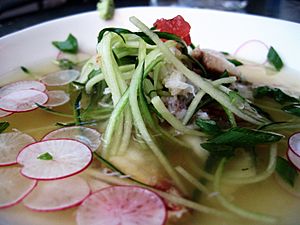Naengguk facts for kids

A bowl of elaborated oi-naengguk (chilled cucumber soup)
|
|
| Alternative names | Chilled soup |
|---|---|
| Type | Guk |
| Place of origin | Korea |
| Serving temperature | Cold |
| Korean name | |
| Hangul | |
|---|---|
| Hanja |
冷-
|
| Revised Romanization | naengguk |
| McCune–Reischauer | naengkuk |
| IPA | [nɛ̝ŋ.k͈uk̚] |
Naengguk (Korean: 냉국) is a special kind of cold soup from Korean cuisine. People mostly enjoy it during the hot summer months. It is also called chan'guk (찬국), which simply means "cold soup" in the Korean language. The word naengguk mixes a Chinese character for "cold" with the Korean word for "soup."
Contents
A Taste of History
The first time naengguk was written about was in a poem. This poem was created by Yi Gyu-bo (1168–1241). He was an important officer during the Goryeo period (918–1392) in Korea.
In his poem, Yi Gyu-bo called naengguk by another name, sungaeng. This name meant a soup made with a plant called sunchae (Brasenia schreberi). Yi Gyu-bo really liked its clear and simple taste. He even said it made other regular dishes seem not as good!
Different Kinds of Naengguk
Naengguk can be divided into two main types. These types depend on how they are seasoned and what ingredients are used.
Sour and Sweet Naengguk
The first type of naengguk is made by mixing chilled water with vinegar. This gives the soup a refreshing sour and sweet taste. Some popular examples include:
- Miyeok naengguk: Made with wakame, a type of seaweed.
- Oi naengguk: Made with cucumber. This is a very common and popular choice.
- Pa naengguk: Made with spring onions.
- Maneul naengguk: Made with garlic.
- Gim naengguk: Made with gim or nori, which are dried seaweed sheets.
Rich and Healthy Naengguk
The second type of naengguk is made to be more filling and healthy. These soups often have richer flavors. They are meant to give you energy and nutrients. Examples include chilled soups made with:
- Chicken
- Sesame
- Soybeans
These different kinds of naengguk offer a cool and tasty way to enjoy soup, especially when the weather is warm!
See also
 In Spanish: Naengguk para niños
In Spanish: Naengguk para niños

